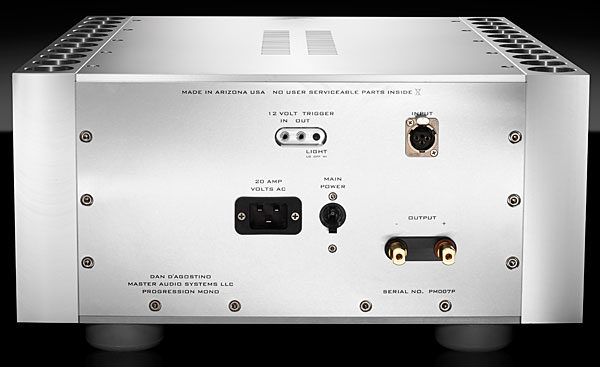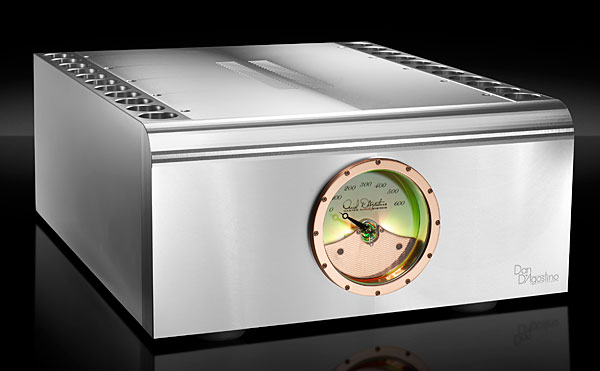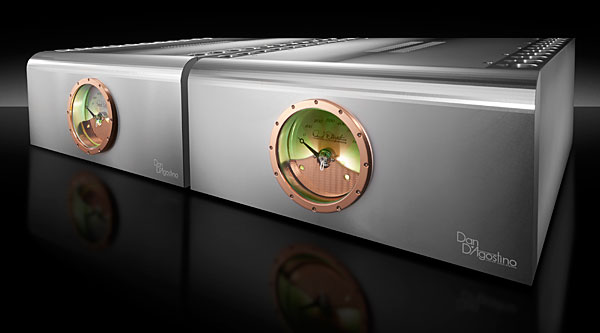Dan D’Agostino Progression M500 Monoblock Amplifiers
Original price was: R860,000.00.R440,000.00Current price is: R440,000.00.
Dan D’Agostino Progression Mono monoblock power amplifier

For as long as I’ve known about high-end audio, I’ve put Dan D’Agostino, co-founder of Krell, on the same pedestal reserved for the likes of Frank McIntosh, Saul Marantz, Avery Fisher, H.H. Scott, and Sidney Harman. The reason is simple: Dan’s the man whose achievements at Krell led me from the harsh sound of my first high-end amp into another dimension, one of truly musical sound reproduction.I still recall the layout of the room where I first met D’Agostino—at an audio show, years before I began writing for Stereophile. I introduced myself in a trembling, fan-boy voice. (I did the same with John Atkinson.) Not many years later, when I found myself the owner of a Krell KSA-50S, its imaging blew me away. While the amp didn’t entirely meet my needs, my Krell experience only deepened my appreciation for D’Agostino’s work.
At the end of 2009, Dan and Krell’s cofounder, Rondi D’Agostino, were forced out of the company by what Dan terms a “hostile takeover,” but he wasted no time in founding Dan D’Agostino Master Systems. The company soon released a series of expensive Momentum amplifiers and preamplifiers, whose sound and distinctive “audiophile jewelry” enclosures further solidified his reputation as a cutting-edge designer (footnote 1). Now comes the less expensive but hardly plain-Jane Progression series.
The moment I heard the first pre-production pair of Progression monoblocks ($38,000/pair), driving Wilson Audio Alexx loudspeakers at Definitive Audio’s 2016 Music Matters event, I wanted them to be the first amps I would review for Stereophile. Alas, when D’Agostino’s longtime associate Bill McKiegan visited my home to install the first pair of Progression monoblocks manufactured in their initial, limited production run, technical problems intruded: First, a loose ribbon cable in one monoblock’s chassis caused it to emit a loud noise. Although McKiegan easily reattached the cable—its new header and pin should prevent future problems—both monoblocks continued to emit an annoying hum that made listening a chore, and compromised all sound above the bass region. This second problem was traced to improper potting in the transformers, an error on the part of the transformer provider, and has since been addressed. Still, it took five months before a replacement pair of Progressions could be freed up for review.
Appearance and Design
The Progression’s enclosure and chassis—in this case, the same thing—is machined from a solid billet of aluminum. Most visually striking are a large, round, copper-rimmed, green-lit power-output meter—it dominates the front panel—and, running along both edges of the top plate, the large holes that replace heatsink fins.
The handsomely designed user manual says that the meter is “driven by a high-speed ballistic circuit that enhances the meter’s responsiveness” and allows it to cover the amp’s entire output range. As I listened to high-resolution recordings while sitting 12′ back from my speakers in my 20′ by 16′ by 9′ listening room, the needle didn’t rise very far, even when I raised the volume to the point of discomfort and every instrument in an orchestra or band was blaring simultaneously. Since I have no desire to stop working for Stereophile, I never tried to find out if my CDs would fall off their shelves before the needles pegged.
Secreted directly under the meter, on the bottom edge of the Progression, is a small, easily accessible On/Standby button. Assuming that these class-AB amps would consume little electricity when music wasn’t playing, I left them on 24/7 to keep them ready for listening, instead of having to wait half an hour for them to reach optimal operating temperature. Even when I spent several hours listening nonstop to complex music with lots of dynamic peaks, the Progressions never got more than warm to the touch. On colder days, I still needed to heat the room.
On the Progression’s rear panel are a 20-amp IEC inlet, a large main power toggle switch, a single balanced (XLR) input—there’s no unbalanced input—and two speaker binding posts that are fairly easy to screw down tight. The large space between cable connections makes it easy to keep wires apart. There are also 12V on/off trigger input and output switches for use with other components (I never used them), and a toggle switch for adjusting the brightness of the power meter (Low/Off/On). I liked the green glow, and left the meter on.

D’Agostino believes that great sound reproduction requires power. Thus, the Progression’s chassis contains a very large, 2.5kVA power supply claimed to deliver plenty of reserve power for peaks in loud rock and classical. D’Agostino says the amplifier “easily” delivers 2000W into 2 ohms. “The Progression . . . will play loud, but it is the control of the speaker drivers I was after,” he wrote in the manual. (To learn more about the Progression and Dan D’Agostino, see “Dan D’Agostino’s Progress to Progression” elsewhere in this issue.)
Listening
When the replacement Progressions arrived, Bill McKiegan returned to ensure that they were working properly. (They were driven directly from the analog outputs of my dCS Rossini DAC.) Normally, when company reps help install gear, Stereophile reviewers thank them for their time but keep their critical impressions to themselves. But I’m a Cancer—an emotional being. Thus, when we put on a familiar SACD of Iván Fischer conducting the Budapest Festival Orchestra in Mahler’s Symphony 9 (Channel Classics CCS SA 36115), and the stone-cold Progressions delivered far more believable air and sense of hall boundaries than any other amps I’ve heard in my reference system, I found it difficult to mask my excitement.
At first, I began my tests with a wide assortment of familiar fare. Yes (check), that eccentric collection of percussion in Lou Harrison and John Cage’s Double Music, with Angel Gil-Ordóñez conducting the Post-Classical Ensemble (24-bit/48kHz WAV file, Naxos 8559825), sounded as tight as could be. There was believable body to the sound, and maximum color differentiation between the composers’ crazy collection of standard and repurposed percussion instruments. And, yes (check), the final track on Ludovic Morlot and the Seattle Symphony’s excellent recording of Stravinsky’s The Rite of Spring (SSM 24/96 WAV file, Seattle 1005) sounded equally outstanding. Not only did the Progression Monos nail the savagery of the high-driving piccolos and brutal bass without breaking a sweat, they also kept every instrument in control and balance while conveying a realistic, airy soundstage and thunderous percussion.
One other thing about the Progressions struck me from the get-go. Perhaps owing to their speed and reserve power, contrasts between soft and loud in hi-rez orchestral recordings were greater and more impactful than with any other pair of monoblocks I’d heard in my reference system.
Turning to Murray Perahia’s performance, on piano, of Handel’s Harpsichord Suite in E, HWV 430 (CD, Sony Classical 62785) left me marveling that, for the first time with any amp in my system, I could hear the resonant space around the piano, and sense the size of the space captured by Sony’s engineers. I also noted that while the sound was just a touch on the warm side of neutral, the tonalities were beautiful, and the piano’s bottom notes sounded more realistic than I’d ever heard them in my system.
Not only did the Progressions clearly convey Perahia’s perfect, rapidly articulated runs in the suite’s final, joy-filled Air with five variations, it also depicted those notes as connected in a continuous, supremely musical flow. As I’ve discovered in listening to this recording countless times at audio shows, some amps overemphasize the spaces between notes, making them sound a bit like machine-gun fire, while others blur the notes together. The Progression made Perahia’s playing sound as musical and technically astounding as it would in real life.
“I love this recording as if new,” I scribbled in my notes. “Everything sounds fabulous.”
Returning to Morlot and Seattle’s Rite, I confirmed that while the sound was a touch warmer than neutral higher in the range, timbres were absolutely believable with timpani and bass drum. Further listens to recordings of percussion, cello, and double bass confirmed that, through my Wilson Audio Alexias, the Progressions excelled at conveying low pitches with more tonal accuracy than I was accustomed to.
I also began to realize that while my reference Pass Labs XA 200.8 monoblocks sound gorgeous, and convey a special glow around the edges of each note, the Progressions illuminated each note from within. The experiences are different but equally gratifying.
I’ve often lamented that my audio reviews have never approached the levels of poetry and flights of fancy that make Herb Reichert’s writing so special. But as I continued to explore familiar and new recordings, I discovered that the Progressions made me want to listen deeper and deeper, and play entire compositions without pausing to take notes. I was seduced without knowing it—and when my head cleared, I imagined the fabled Sirens, who beckoned sailors to their deaths, luring me with their spell. Herb may be able to paint a better verbal picture of what I experienced—he’s a visual artist, after all—but the call of the Progressions was so strong that, on multiple occasions, hours of listening went by without my remembering to use the pen I held in my hand.
A great amp will do that to you.

Somewhere in my journey—when you’ve fallen in love, it’s hard to remember such practical considerations as numbering the pages of whatever notes you do manage to take—I played “Insensatez,” from Rosa Passos and Ron Carter’s Entre Amigos (CD, Chesky JD247). In short order, I realized that I could hear guitarist Lula Galvão’s fingering and the pitches of Carter’s double bass as never before. Rather than sounding etched—the Progressions never sounded detailed to the point of being clinical—the D’Agostino’s revelations of additional detail only brought the music closer to me. Ditto with “Black on White Paper” and “This Screaming Dream,” from Zen Widow’s Screaming in Daytime (Makes Men Forget) (CD, pfMentum PFMCD 069): I could hear slight, previously masked noises and ticks in the right channel as percussionist Garth Powell and his fellow musicians picked up and moved instruments. This CD was recorded on two-track analog tape by Joe Harley, and mastered by Bernie Grundman—the depth, width, and height of its soundstage blew me away.
As weeks went by, reviewing recordings for Stereophile.com became more of a joy than ever. Through the Progressions, Yo-Yo Ma, Chris Thile, and Edgar Meyer’s recording of various works by J.S. Bach arranged for mandolin, cello, and double bass (24/96 WAV, Nonesuch 558933/HDtracks) revealed all its glories and shortcomings; while the sense of space in Rímur, the flawless pairing of Trio Mediaeval and trumpeter Arne Henriksen (24/96 download, ECM New Series 2520), positively tranced me out. I was also amazed that while David Chesky’s download-only hi-rez recording of his song cycle The Spanish Poems, with soprano Maureen McKay and the Orchestra of the 21st Century (Chesky/HDtracks) was limited to 24/48—his usual DAC was being repaired—its spacious soundstage and color-rich palette suggested something of far higher resolution.
One of my most joyous listening sessions was with a new friend, a viola da gamba player, who’d recently moved to Port Townsend and attended a potluck we hosted. When he asked to hear Jordi Savall and his ensembles’ M. A. Charpentier à la Chapelle Royale de Versailles (SACD/CD, Alia Vox AV DVD 9905), we sat stunned by the melding of beautiful voices with early instruments. Wishing my guest to hear more of how well the Progressions did with voices, I turned to Puccini’s “Che gelida manina,” from Franco Corelli’s The Unknown Recordings (CD, EMI 5626992), and Verdi’s “D’Amor sull’ali Rosee,” from L’art de Montserrat Caballé, Vol.2 (CD, Forlane UCD 10905). When tenor Corelli opened up on his glorious high C, and incomparable soprano Caballé transitioned from mere threads of sound to full-throated outpourings, the dynamic contrasts were something to behold—even within the Compact Disc’s limited dynamic range.
My final extended listen to the Progressions was with members of the Pacific Northwest Audio Society. We didn’t compare amps, DACs, or anything else—we just enjoyed what the Progressions could offer. For much of the afternoon, I found myself turning off the lights so that, with the room illumined only by indirect light coming from a hallway window, we could sink even deeper into the music.

Some of our selections included tracks from Yello’s Toy (24/48, Polydor) and streams of music by trumpeter Arturo Sandoval (16/44.1, Tidal HiFi). While both were flawlessly delivered—the Progressions controlled the pounding low end of Yello’s “Electrified II” without sweat while throwing a huge soundstage—the most startling track of all was one I’ve played countless times: soprano Maria Callas singing the Sleepwalking scene from Verdi’s Macbeth, recorded in 1958 for her album Callas Portrays Verdi Heroines, with Nicola Rescigno conducting the Philharmonia Orchestra (24/96 file, Warner Classics). Not only could I hear more details of Callas’s vocal production than ever before, but I also discovered that solo instruments in the orchestra were surrounded by what sounded like unprecedented amounts of air. That the flute stood out so hauntingly, as if singing in the dark, confirmed that Verdi and Rescigno intended every sound of the orchestra to underscore Lady Macbeth’s bloodthirsty madness. To use a descriptor favored by John Atkinson, I was gobsmacked.
Conclusions
As I write these words, the Progressions sit boxed up, awaiting shipment to JA’s house. With the first few reviews I wrote for Stereophile, each such farewell was accompanied by the gnawing fear that John’s measurements would lead him to write, “These are some of the worst-measuring amps ever to cross my threshold,” and reveal me as a total dolt (footnote 2). I harbor no such fears about the Dan D’Agostino Master Audio Systems Progression Mono. Instead, I’m eager to discover if JA’s tests will help explain how these monoblocks produced such detailed, natural-sounding, air-filled, ultra-dynamic, supremely musical sound.
While the Progression wasn’t the most neutral-sounding amp on the planet, its mild warmth in no way interfered with its ability to communicate the visceral, emotional, and spiritual imports of music. Delicate music sounded exactly that, while ultra-aggressive percussion, screaming horns, and cries of pain—imagine some diabolical cross between Shostakovich, Diamanda Galas, and Metallica—only gained in impact from the Progressions’ ability to reveal it in all its glory. “Wow!” only begins to tell the tale.
The voltage gain, input impedance, and frequency response of this sample were identical to those of the first, though the output impedance was slightly lower, at 0.32 ohms, and there was no RF noise present at the amplifier’s output. And when I examined how the percentage of THD+N varies with output power, this sample clipped at 595W into 8 ohms (fig.4), which is 0.8dB higher than the 500W specification. Into 4 ohms, the clipping power was 934W (fig.5); though this is 0.3dB lower than the specification, I don’t hold the wall voltage constant during these tests, feeling that this is more representative of an amplifier’s behavior in a typical system. The wall voltage was 120.1V with the amplifier idling, but had dropped to 115.4V at 934W into 4 ohms.
Description
Finish
Silver
Black
Custom Finishes Available Upon Request
Power
500 watts @ 8Ω
1,000 watts @ 4Ω
2,000 watts @ 2Ω
Frequency Response
1 Hz to 200 kHz, -1 dB
20Hz to 20 kHz, ±0.1 dB
Distortion
800 watts @ 8Ω
0.15% @ 1 kHz
Signal-to-Noise Ratio 105 dB, unweighted
Inputs
1 balanced XLR
Input Impedance
100 KΩ
Output Impedance
0.15Ω
Dimensions
18 x 20 x 7.5 in.
Weight 150 lbs.

















